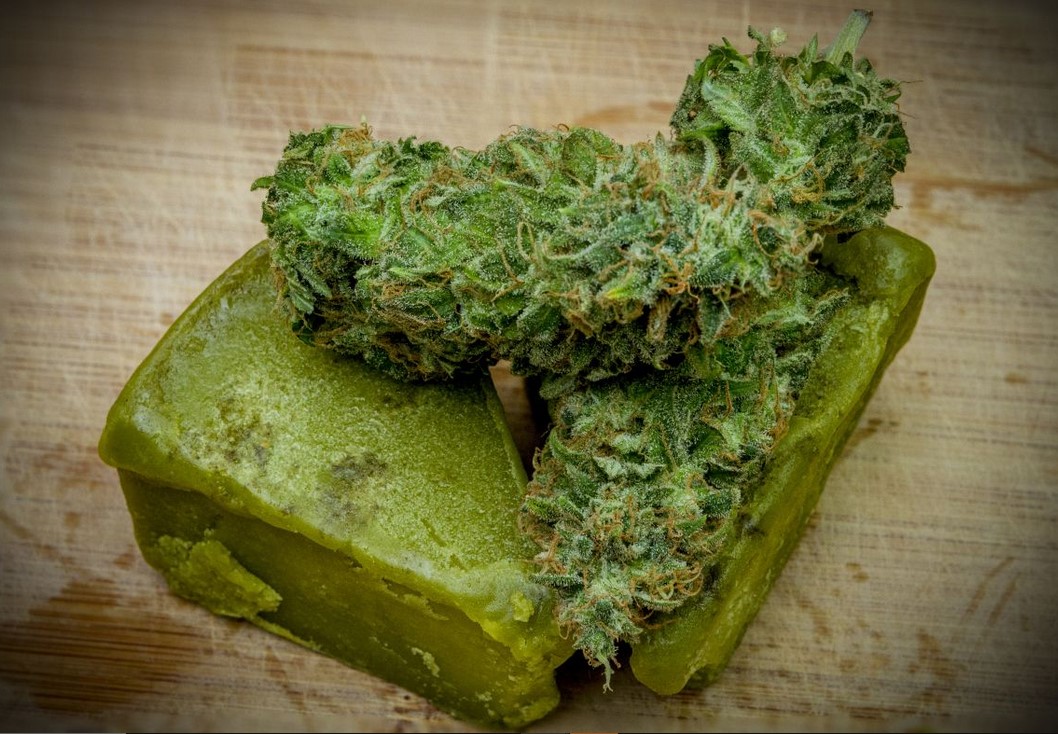Uncategorized
A Beginner’s Guide to Making Cannabis Butter
Marijuana edibles have been around for a long time. In fact, it’s likely that people ate the plant (rather than smoked it) in order to recognize it. Cannabis’ textiles, health, and psychoactive effects were discovered by the Chinese sage emperor Shennong 5,000 years ago.
According to legend, both a slave and Emperor Shennong himself were caught off-guard by a leaf falling into the emperor’s boiling tea. The emperor drank the tea, became fixated on cannabis, and began researching its applications. He eventually chronicled his discoveries—which included treatments for gout, rheumatism, malaria, and forgetfulness—in the Pen Ts’ao Ching pharmacopeia. From there, marijuana was used in India, the Caribbean Islands, and across the world until it reached your local marijuana farm.
However, simply because Emperor Shennong felt the effects after steeped a leaf in boiling water doesn’t imply you can achieve the same thing with all of your edibles. You don’t just throw Sour Diesel buds into a batch of cookies dough. That won’t work. It takes some effort first. However, trust us when we say that it’s well worth your time. Making cannabutter or weed butter at home (for short, cannabutter or weed butter) is one of the greatest methods to cook with marijuana (short for cannabutter or weed butter).
Cannabis butter, as the name implies, is a kind of butter that contains THC and other marijuana compounds. It can also be used in place of ordinary butter in all your favorite recipes because it’s basically identical to regular butter. Here’s how to make your own weed butter.
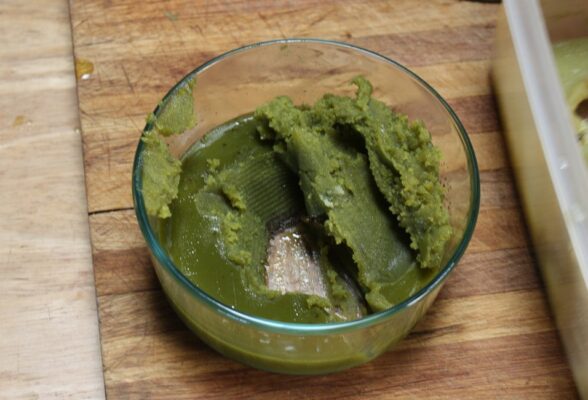
It’s Not Just Raw Weed & Butter
It’s not as simple as dumping a spoonful of your favorite strain into the cookies, marinara sauce, brownies, or waffles. “Why?” you ask. Excellent question.
Raw marijuana, on the other hand, is not psychoactive. Your body can’t break down the raw marijuana plant material in a way that allows the cannabinoids to enter your circulation. At best, your body would digest it like any other leafy green. At worst, your body may reject the raw plant material, resulting in vomiting, diarrhoea, and other stomach issues.
Second, raw marijuana is unpalatable. That flavor may significantly impact the flavor of everything you put it in. You don’t want your delectable chocolate chip cookie recipe to be ruined by the harsh, unpleasant-tasting stuff that was supposed to make you jump around on the ceiling.
Even if you buy dried bud from your local dispensary, it isn’t ready to consume right away. That’s because, in order for the plant material to be more usable (and enjoyable), a smaller amount of THCA and CBDA must first be converted into THC and CBD. You must decarboxylate your marijuana before getting the most out of it. Here’s what you need to know about decarboxylation.
The Importance Of Decarboxylating Your Cannabis
The term “decarboxylation” is made up of two words that, when deconstructed and interpreted, provide us some insight into the procedure. Let’s begin at the beginning.
- De—A prefix that, among other things, means removal or to remove.
- Carboxyl—A chemical term for the acid radical group COOH found in most organic substances.
- Ation—a suffix that, among other things, means action.
That’s all there is to it. Now add everything together and you’ve got yourself a nice little cocktail of compounds. The action of removing the carboxyl group is what you’re looking for. Raw, as well as dried cannabis material, contains tetrahydrocannabinolic acid (THCA) and cannabinolic acid (CBDA), in various quantities. You can see from the image below that extra CO2 is required to convert THCA into THC. In the center portion of the picture, you’ll notice something odd. That tells you how to turn an apparently useless molecule (THCA) into one you can’t live without (THC).
So you’ve got your raw cannabis, and you’re contemplating what to do with it: smoke it or bake it in a pie? If you decide to smoke it, you’re decarboxylating the cannabis by lighting it on fire. However, if you intend to use your marijuana in edibles, things are a bit more complicated. Because after being burned with fire, it’s lost forever.
To utilize cannabis in edibles, it must first be decarboxylated at a lower temperature for a longer time. What temperature and for how long? In steps one and two of the butter-making process below, we’ll give you those figures.
Before that, however, it’s vital to understand why decarboxylating your cannabis at low temperatures for extended periods of time is a good idea. It’s all about terpenes.
What Are Terpenes?
Terpenes are natural oils that exist in cannabis plants and give it its distinct aroma and flavor. You’re a fan of a particular combination of terpenes if you enjoy the diesel scent given off by certain strains. You’re a lover of a specific combination of terpenes if you can’t get enough of the Girl Scout Cookie strain’s flavor. They collaborate with cannabinoids to provide specific medical benefits in addition to working together with cannabinoids to give distinct medical effects.
So, what does the decarboxylation process have to do with terpenes? Everything. When cannabis is heated above 310 degrees Fahrenheit, terpenes begin to break down. Even though the trip from the burning end of the joint or bong to your lungs is rapid, you still get some of the terpenes when you smoke marijuana. However, decarboxylating cannabis for edibles is a different story. To preserve the terpenes, the process needs lower temperatures (below 310 degrees Fahrenheit), which implies a longer application of heat. So we can’t just put our oven to 400 degrees and bake the weed for 10 minutes. No, we’ll need much cooler temperatures and extended baking times.
How To Incorporate Cannabis Into Your Favorite Recipes
There are numerous methods to ingest marijuana in the form of an edible. You may mix it with juice or other beverages to make a tincture. Decarboxylated cannabis might be added to your salad instead of harsh greens (instead of bitter greens). But, if you want to sneak cannabis into almost any dish, one of the simplest and most adaptable ways is to cook with cannabis-infused butter. Because, after all, butter is used in pretty much every baking recipe. When sautéing, you can utilize butter. When preparing eggs in a pan, you may use butter to grease the surface. For a delectable THC treat, spread cannabis butter directly on your toast, rolls, or biscuits.
That’s why we’ve dedicated an entire article to the process of cannabis butter creation. So now that we understand what we’re doing, let’s get down to business and make our own batch of cannabis butter.
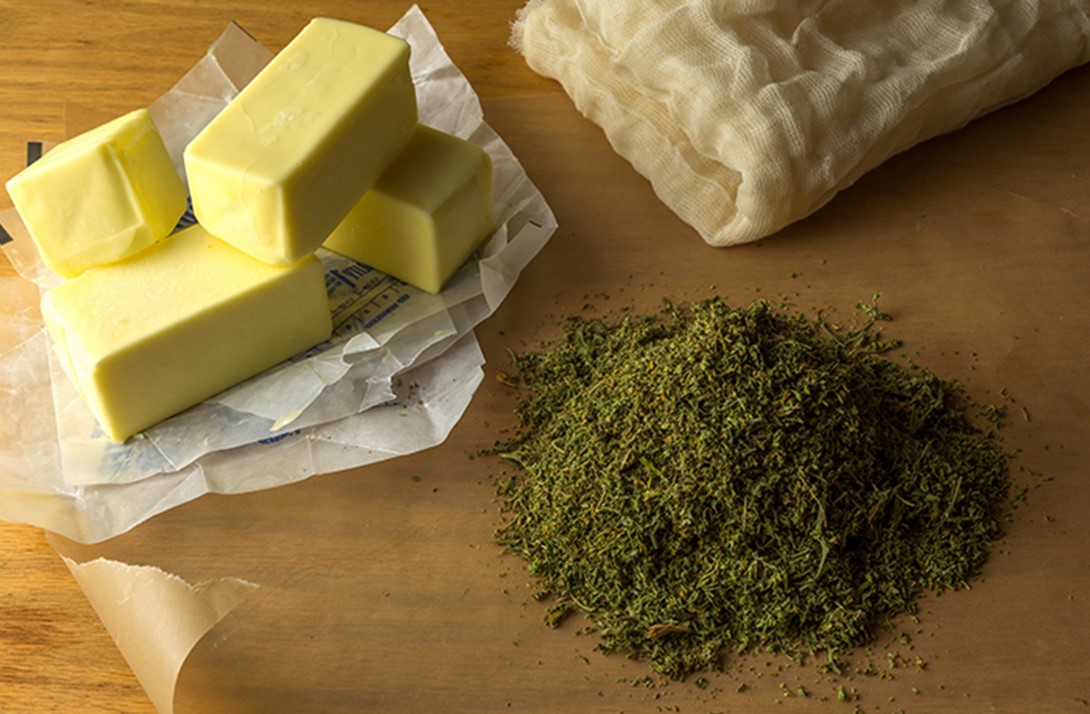
How To Make Cannabis Butter
What you’ll need
- Oven
- Stove
- Baking sheet
- Your favorite bud(for ex. Blue God)
- Medium saucepan
- Butter
- Bowl for finished product
- Cheesecloth
- Rubber band, string, or tape
- Hotpads
- Cutting board
Step 1
Preheat the oven to 240°F. While the oven warms up, spread your plant material in a single layer on a baking sheet. One with sides is ideal so you don’t lose any of your precious ganja. However, if you’re in a hurry, one without sides will do just fine. You’ll simply have to be more cautious.
Step 2
Bake the cannabis for 40 minutes on a baking sheet at 350°F. Turn the sheet over several times to ensure that all of the cannabis is cooked. We spoke about decarboxylation above, but it’s worth mentioning again here. Remember that decarboxylation activates THC and CBD, making your bud more easily digestible in your stomach. If you don’t decarb (or decar) your bud, you may still receive some benefits, but it’s critical if you want to enjoy the highs and benefits of incorporating your marijuana into food.
After cooking your cannabis for 40 minutes, it should be dry and powdery, and you’re ready to combine it with the butter.
Step 3
You’ll also need the butter for this stage. But what is a reasonable amount? A good rule of thumb is to use four sticks of butter for each ounce of marijuana. So, if you consume half an ounce of cannabis, you’ll require two sticks.
In a medium saucepan, combine 4 cups of water and bring to a boil. On the stove, simmer until ready. Stir your butter into the boiling water until completely melted. It won’t take long at all.
Step 4
The hard part now is waiting: reduce the heat so you don’t burn the marijuana. Turn down the stove so that the mixture simmers gently. This should be a low-heat process.
Step 5
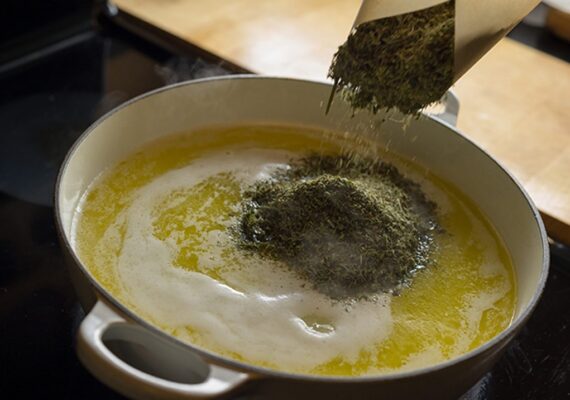 Allow three hours for the butter/water/marijuana combination to simmer. You have a lot of time on your hands, so go through Step 6 and then return here.
Allow three hours for the butter/water/marijuana combination to simmer. You have a lot of time on your hands, so go through Step 6 and then return here.
The three-hour simmering process removes a portion of the water. Keep an eye on the top of the mixture near the end of the three hours. It will go from watery to thick and glossy. That’s when it’s done. Remove the pan from the heat after three hours have passed.
Step 6
While the butter/water/marijuana mix is heating, prepare your big mixing bowl. You’ll be pouring the hot liquid into the bowl, so make sure it’s heatproof. A Pyrex, plastic, or metal mixing bowl works well. Just be careful that it can handle all of the mixture in the pan.
Place the mixing bowl in a pot, add boiling water to half-fill it halfway, and stir. Place two pieces of cheesecloth on top of the mixing bowl with a rubber band, string, or tape. We like string because it doesn’t pull and keeps the cheesecloth in place well. You’ll be pouring a hefty mixture into the cloth, so make sure you have enough to keep it from slipping through the string.
To finish, secure the string around the smaller diameter of the bowl (towards the bottom where the bowl curves). This is crucial so that when straining the mixture, the string does not simply slide up and over the lip of the bowl.
Step 7
You may want to put on your hotpads now, since you’ll be dealing with some rather hot liquids. Pour the mixture slowly through the cheesecloth. The weed butter will result from what goes through the cheesecloth. The substance on top of the cheesecloth will ultimately be thrown away.
Step 8
When the pot is empty, grasp the four corners of the cheesecloth and make a little bag of it. You may even twist the top to keep everything in.
Remove every ounce of that precious butter by squeezing the cheesecloth and goo within.
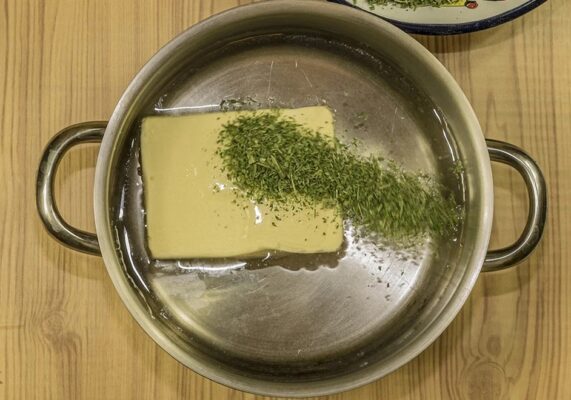
Step 9
We’ve reached the final step: waiting. We’re just one more hour away from finishing. I swear it.
Allow the weed butter to come to room temperature before placing it in the refrigerator. During this hour, any remaining water in the mix will separate from the butter. When you remove the top layer of solidified weed butter, it’s done.
Step 10
That’s all there is to it. To separate the butter from the mixing bowl, run a knife around the edge of the weed butter as you would on the outside of a cake pan. With care, carefully remove the weed butter from the mixing bowl and set it on your cutting board. Remove any remaining water using scraping or gently moving with a clean towel if necessary.
Cooking with weed butter
There are several amazing weed butter recipes available. If you’ve never eaten marijuana via food before, keep in mind that the effects can be quite different.
One of the downsides is that the effects may take 30 to 190 minutes to manifest. Yes, you read that correctly. That unique brownie you just ate might take up to 3 hours for you to get high. This is due to food’s digestion in your stomach. There is one redeeming aspect about this delay: because cigarettes and joints are smoked more slowly, they produce a far greater high than marijuana alone would have done. When rolling a common joint, you use around 0.5 grams (500 milligrams for those who prefer bigger numbers). 0.001 grams is a good place to start when consuming cannabis (or 1 milligram). When cannabis is eaten, it becomes considerably more powerful. So don’t be anxious and eat more. You’ll only wind up disappointed.
For another thing, because the THC is absorbed directly into the circulation rather than being filtered (to some extent) in the lungs, cannabis-infused edibles are far more powerful. Furthermore, the high can be felt for a longer period of time.
Finally, having too much THC can cause anxiety, nausea, hangover, and a negative vibe in general. As a result of these factors, it’s usually a good idea to start small and gradually when using cannabis edibles. Try not to get too high too quickly or you will be put off by edibles for life. That would be a shame.
If you do get too high too quickly, try the following measures to assist you come down.
- Lemon, lime, orange, or grapefruit are good choices. You may also consume the juice from any citrus fruit instead. This works because the citric acid in the citrus fruit inhibits THC absorption.
- Inhale essential pine oil (but don’t eat it). The aroma of this oil will assist you in clearing your thoughts.
- Add some pistachios or pine nuts to your dish. The fats and other chemicals in these nuts will aid in the reduction of the THC’s high-flying effects.
For people who don’t want to smoke cannabis but still desire the pain-relieving, high-flying effects, consuming it is a fantastic option. Visit your local dispensary and inquire about a product they recommend if you want to try eating marijuana in food before making your own.
Have you had a positive experience with weed butter or edibles in general? Leave a comment below with your story.


